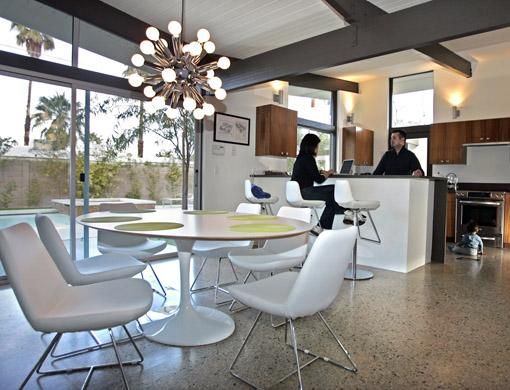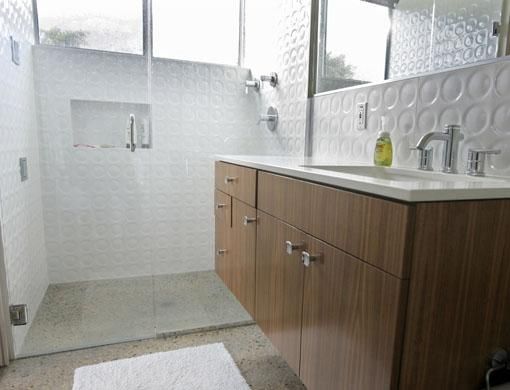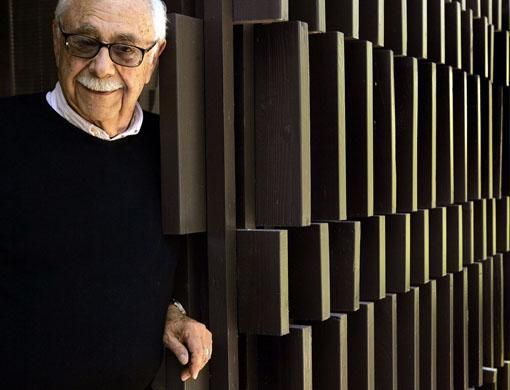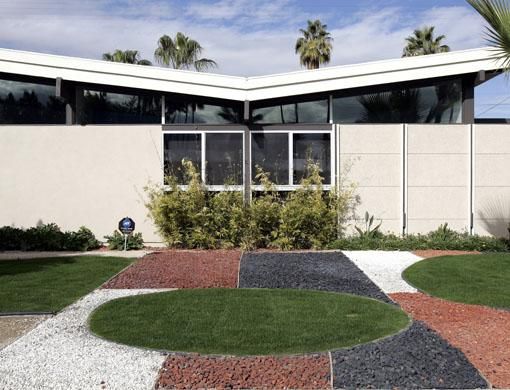Jennifer Cabalquinto and Howard Joyce had put a deposit on a house in a gated golf community when their realtor steered them to yet another new home, which she said was by architect William Krisel.
“We'd never heard of Krisel,'' Cabalquinto recalls. “We were on our way home. Our infant son was fussing in his car seat. We didn't even want to go in.''
They did it to please the agent. And a few minutes later, they emerged “totally in love with the place'', Cabalquinto says. “It was instantaneous for both of us.''
The couple made an immediate full-price offer and moved into the just-built house seven months ago.
The design that instantly enchanted them isn't new at all. It's a reproduction of a 1955 home by Krisel, updated to contemporary codes and filled with 21st-century technology.
The open floor plan, the high beamed ceilings, the walls of glass and the clerestory windows that offer glimpses of sky and swaying palms are exactly as the architect envisioned 53 years ago.
A new plan
Wide, curving streets front gardens behind which Krisel carefully angled the houses in varying positions on their 100-foot-square lots.
He alternated styles of roofs, so that each house looked different.
A casual observer still might take these streets for charming communities of custom-built homes but all were mass-produced and have the same floor plans, Krisel says.
He helped to break the mould for affordable housing not only in Palm Springs but also in suburban Los Angeles, in the 1950s.
Although Krisel went on to design high-rise office towers, condominiums, hotels and hospitals, those modest post-and-beam tract houses have become iconic.
Krisel was a young married man, fresh out of the University of Southern California and stints in the studios of noted architects Paul Laszlo and Victor Gruen.
He looked for a niche not yet tackled and found it in a fortuitous friendship with Bob Alexander, son of builder George Alexander, who was putting up tracts of unattractive but affordable houses for the postwar generation.
So Krisel also drew up some plans, told his friend Bob that his houses would sell better and make more money than the ones his father was building.
“But Bob's father thought we were nuts. He wanted to teach us a lesson, so he gave us land in the San Fernando Valley to build 10 of my houses as a test,'' Krisel says.
Krisel's homes not only sold fast but also made more profit than the company's unattractive houses.
Impressed with the work Alexander suggested they build slightly larger, more luxurious Krisel tracts in Palm Springs as vacation homes for the same budget-conscious customers.
Weekend home
Cabalquinto, 38, and Joyce, 37, spend weekdays in their house in the Mount Washington but it's their retreat in Palm Springs that they think of as home.
“We spend almost every weekend here,'' says Cabalquinto, chief financial officer of Universal Studios Hollywood. “It's where we celebrate Thanksgiving and Christmas, where we invite family and friends.
This is our keeper, the one we want our son Jack to inherit when he grows up.''
Their new, three-bedroom, two-bath house gives them mid-century modern design, which they love, but with 21st-century amenities: updated climate control, tankless water heater, stainless steel kitchen, luxury bathrooms and extra storage space built into the two-car garage.
“It's the best of both worlds,'' Cabalquinto says. She and her husband, a management consultant, had looked at vintage homes in the area but they all needed work.
“We have demanding jobs and a baby — we didn't want such complications.''
Love at first sight
When they walked into Krisel's new version, they “instantly felt it was ours'', she says. “It was so perfect, so light, so spacious. It makes you feel relaxed.''
What sealed the deal, she adds, were the twin palms in the yard. “We had twin palms as the motif for our wedding. This house was meant for us.''
The couple's “keeper'' never would have been built if it weren't for two Canadian brothers, Bob and Michael Friedman, who wanted to escape with their parents from Calgary's winter chill.
For one month they rented a Palm Springs house that happened to be a vintage Krisel design. What beguiled them was nothing so superficial as its good looks.
“It was the extraordinary experience of living there,'' Bob Friedman says. “The floor plan was open but gave us so much privacy.
There was a great relationship between indoors and out. The walls of sliding glass doors, the clerestory windows — looking up, you saw the tops of palms and mountains.
Or else the garden and pool. From almost every room there was outdoor access. We felt like we were part of the landscape.''
Evaluating the designs
Being builders, he says, they realised “there was genius in the simple post-and-beam design, like a child's puzzle. Krisel had pared the house down to essentials''.
They phoned Krisel, who since his retirement has been doing forensic architecture, which focuses on investigating structural flaws in buildings.
The brothers asked him to use his original plans to duplicate the house they loved so much.
Krisel relented but afterwards signed a contract that gave him “total design control over every inch of the project''.
Back to basics
He's not amazed by the renaissance of his early work, he says. “After all, modernism isn't a style or a trend. It's a language, a philosophy.
The components of a structure become its ornamentation.''
After Krisel drew plans to meet present codes, a crew took only four months to build the house that Cabalquinto and Joyce purchased, Bob Friedman says.
Present economic conditions have caused the Friedmans to put mass construction on hold but they hope to build a new community of Krisels in the desert.
Krisel shrugs at the notion. “My contract with them is for five years and 500 houses,'' he says. “I've already designed about 40,000 dwellings in my career.
I don't get too excited about a few more.''













